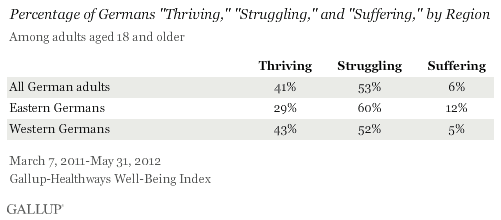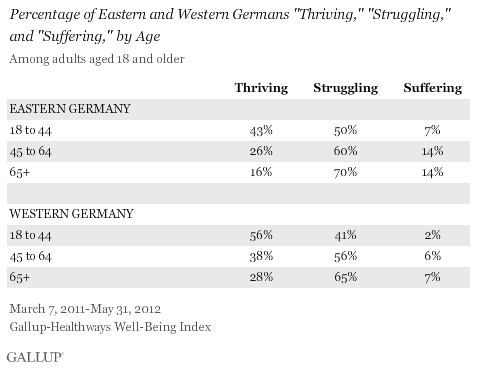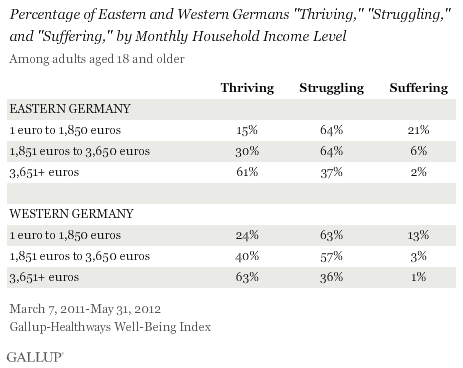BERLIN -- Adults living in East Germany are twice as likely as adults in West Germany to rate their lives poorly enough to be considered "suffering," at 12% and 5%, respectively. Germans in the West are significantly more likely than those in the East to be "thriving" -- 43% vs. 29%, respectively.

The lower life ratings in East Germany compared with West Germany are likely at least partly reflective of the long-term economic disparities between the two regions. GDP per capita in the East is still about a quarter below Western levels and unemployment is almost double the rates seen in the West.
Gallup classifies respondents as "thriving," "struggling," or "suffering" according to how they rate their current and future lives on a ladder scale with steps numbered from 0 to 10 based on the Cantril Self-Anchoring Striving Scale. Respondents are considered thriving if they rate their current lives a "7" or higher and expectations for their lives in five years an "8" or higher. Those who rate their current or future lives a "4" or lower are classified as suffering. All others are considered struggling.
Gallup and Healthways have been tracking Germans' well-being monthly as part of the Germany Gallup-Healthways Well-Being Index since March 2011.
Suffering Higher in East Germany Across All Age Groups
Adults living in eastern Germany, regardless of age, are about twice as likely as those living in the West to be suffering -- and are less likely to be thriving. However, suffering increases with age in both regions of the country, while thriving decreases.

High-Income East Germans Close the Gap With the West
Low- and middle-income Germans living in the East are more likely to be suffering than are their counterparts living in the West. For example, 21% of low-income Germans (those making 1 to 1,850 euros per month) living in the East are suffering, compared with 13% for this income group living in the West. In contrast, high-income Germans (those making 3,651 euros or more per month) living in the East are about as likely to be suffering and thriving as are high-income Germans living in the West.

Men and Women Rate Their Lives Worse in the East Than in the West
In eastern and western Germany, men are slightly more likely to be thriving than women, by 30% to 27% in the East and by 45% to 42% in the West. However, men and women living in the East are considerably less likely to be thriving and considerably more likely to be suffering than are their western counterparts.

Implications
Two decades after the fall of communism, Germany has not fully closed the gap in living standards and well-being between the eastern and western halves of the nation. In fact, the well-being of Germans living in the East is worse than those living in the West, irrespective of their age and gender and to some extent income. Only high-income Germans in the East report equivalent levels of well-being to those seen in the West.
Previous Gallup research has shown that these differences between the East and West also pertain to health outcomes. Together, these findings paint a picture of a divided Germany -- one in which those in one part of the country are faring much better than are those in the other -- a situation that could pose long-term issues for the economic and psychological health of the nation as a whole.
About the Gallup-Healthways Well-Being Index
The Gallup-Healthways Well-Being Index tracks well-being in the U.S., U.K., and Germany and provides best-in-class solutions for a healthier world. To learn more, please visit well-beingindex.com.
Survey Methods
Results are based on telephone interviews conducted as part of the Germany Gallup-Healthways Well-Being Index survey March 7, 2011-May 31, 2012, with a random monthly sample of approximately 950 adults, aged 18 and older, living in Germany, selected using random-digit-dial sampling. The total sample for this period was 14,449 adults.
For results based on the total sample of national adults, one can say with 95% confidence that the maximum margin of sampling error is ±1.0 percentage points. The margin of sampling error for most subgroups is ±1.6 to ±4.2 percentage points, but in East Germany, it is as high as ±4.7 percentage points for the 18- to 44-year-old age group and ±6.1 percentage points for the high-income group (3,651+ euros).
Interviews are conducted with respondents on landline telephones and cellular phones.
Samples are weighted by gender, age, education, region, adults in the household, and cell phone status. Demographic weighting targets are based on the most recently published data from the German Statistics Office. All reported margins of sampling error include the computed design effects for weighting and sample design.
In addition to sampling error, question wording and practical difficulties in conducting surveys can introduce error or bias into the findings of public opinion polls.
For more details on Gallup's polling methodology, visit https://www.gallup.com/.
